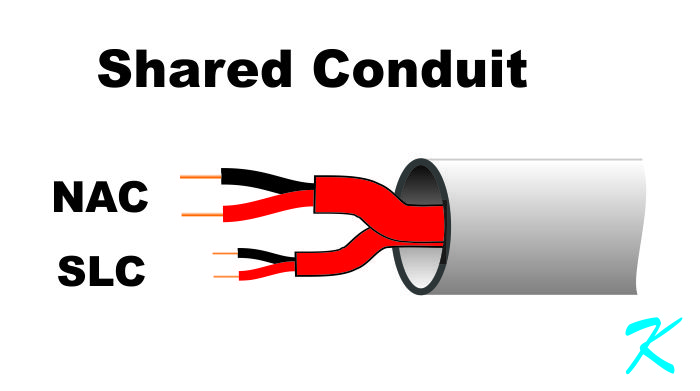There are several parts to the question about whether the Notification Appliance Circuit (NAC) and the Signaling Line Circuit (SLC) can share the same conduit:
- Is there a "Code" in one of the National Fire Protection Association (NFPA) publications?
- Has it been tested by a third-party, nationally known Testing Laboratory like UL, ULC, FM, CE, etc.?
- Does the manufacturer of the system know of any technical issues in sharing conduit?
- Is there a technical or electronic problem with sharing the conduit?
The question about conduit sharing is one of compatibility. The NFPA is concerned with compatibility, but the NFPA is really a law-based publication, and the laws don't show what's compatible.
To find out if two devices are compatible with each other (they have been tested together and are shown in the test results as working together - reliably), tests have to be performed by a third-party, nationally known testing laboratory like UL, ULC, FM, CE, etc. Testing laboratories, though, have limits; they can only test what the manufacturer designs.
Manufacturers often specify what kind wires should be used for the SLC and for the NAC. If they know about an issue, they would be the best resource to finding out what can and can't be done. However, they also have limitations to what they know about; they don't know about your exact wiring layout. You might want to check with their technical support, anyway, to make sure they don't know of an issue.
If you've checked with the manufacturer (who doesn't know exactly how you've run the circuits), if the design is not in violation of what the third-party testing laboratories say, and the NFPA doesn't directly specify that the circuit layout is bad, then it's up to whether or not there's an electronic problem.
Remember, though, that even if the NFPA approves the design, even if the testing laboratories approve the design, and even if the manufacturer doesn't know of any issues with the design, if there's interference so the circuits don't work together, the circuits don't work together.
Is There a Technical Issue? - Crosstalk
Crosstalk is transformer action, and as such, crosstalk only occurs when there is varying (AC) current through a wire. The varying current generates a varying magnetic field. The varying magnetic field induces varying power into the other wires. The greater the distance the circuits are together; the more crosstalk. The more AC current in the transmitting wire; the more crosstalk.
Crosstalk is where you have one circuit, using transformer action, transferring power and signals to the other circuit. Either circuit can transmit to the other and can have immediate consequences, have delayed consequences, or even consequences that only occur under very strict circumstances. There isn't much of a difference between an official transformer, that has wires wrapped around an iron core, and an iron pipe enclosing some wires. It may not be as efficient as an official transformer, but the wires and conduit still make up a transformer.
Usually, as long as the current types in all circuits are the same, there is no noticeable crosstalk. However, when mixing high current wires (like a NAC for the horns and strobes) and low current wires (like an SLC), there is a small possibility of the NAC interfering with the SLC. Remember that there's AC synchronizing signals riding on the DC of the NAC, and the AC synchronizing signals have a slim possibility of interfering with the SLC. If there's no code, testing, or manufacturing issues with combining the NAC with the SLC, use the good wiring practice of keeping the wires out of the same conduit as much as possible.
If the NAC carries amplified audio to the speakers, that amplified audio can easily interfere with the SLC, causing ghost troubles on the panel. These problems are difficult to find and fix. The SLC can also get into the speaker NAC and be heard in the speakers. This also becomes a ghost problem that is difficult to detect and fix. In other words, the two circuits can magnetically couple interference to each other.
No sound reinforcement audio person will run amplified audio wires with any other wire. Electronic feedback can occur, or other interference problems occur. A good wiring practice is to avoid running an amplified audio NAC with any other wire, with or without conduit, for any distance.
NFPA, Testing Laboratories, Manufacturer, Good Wiring Practice
Bottom Line - If the NAC is for fire horns and strobes, the NAC is mostly a DC signal and sharing the same conduit for a short distance probably is not an issue. If the NAC is for the speakers, the NAC is an AC transmitting and receiving wiring circuit (plenty of magnetic coupling of signals - both ways). Sharing the same conduit at all is a real problem and should be avoided at any cost.
No matter what the NFPA says, no matter how much testing has been performed, no matter that the manufacturer doesn't see an issue, if the circuit doesn't work, the circuit doesn't work. Good wiring practice trumps them all.
Douglas Krantz
